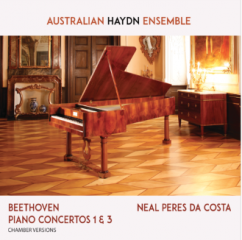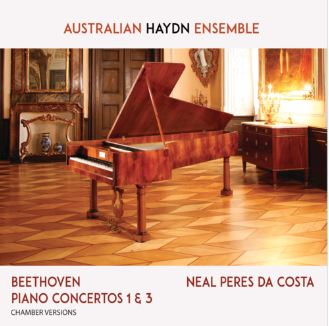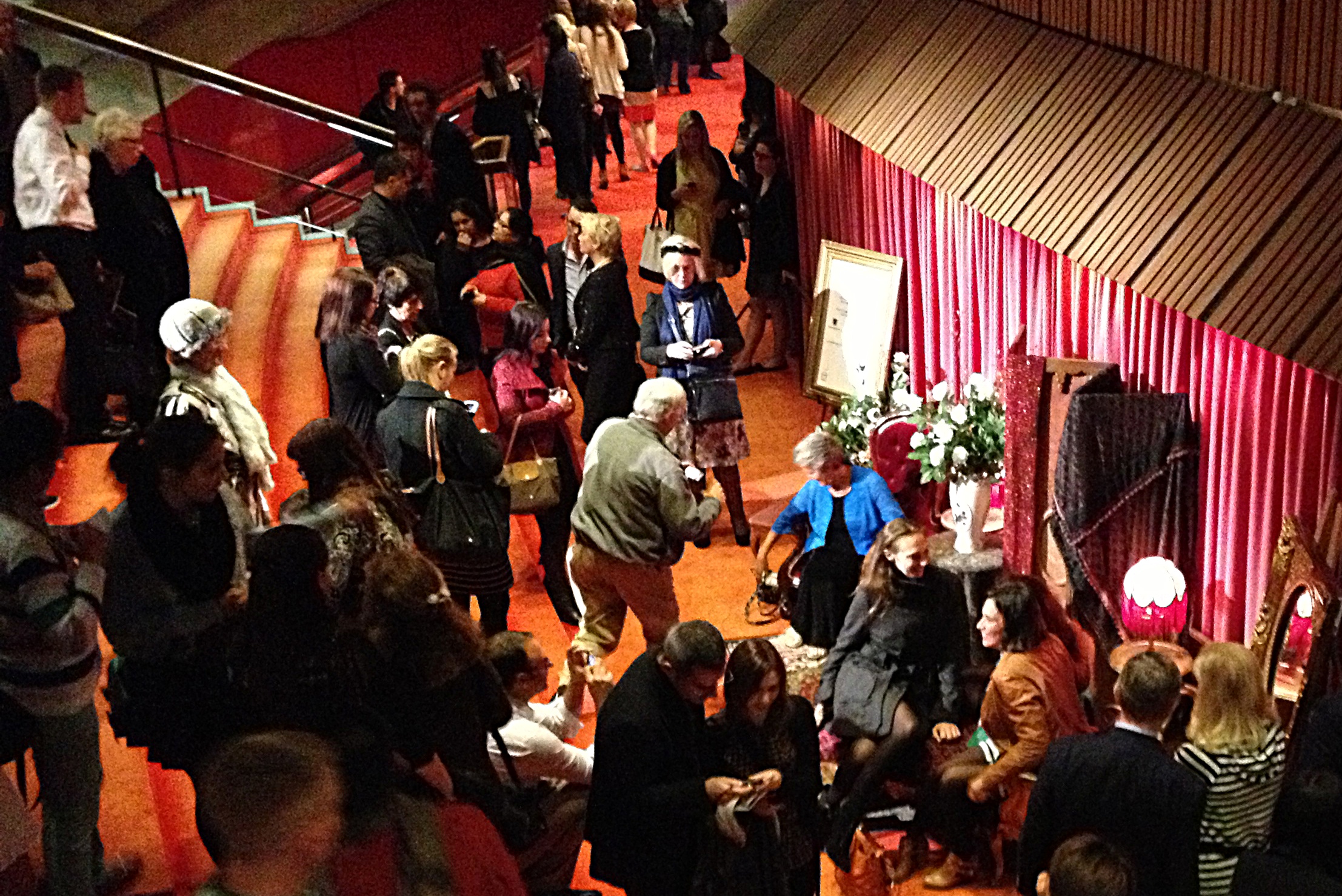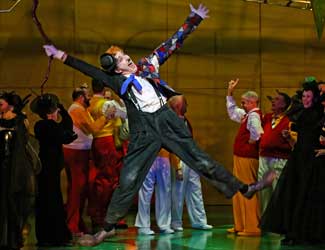Album Review: Beethoven Piano Concertos 1 And 3/ Australian Haydn Ensemble/ Peres Da Costa

The Australian Haydn Ensemble’s recently released second album features Neal Peres Da Costa as soloist in chamber arrangements by Vi King Lim, of Beethoven’s Piano Concerto No 1 in C major opus 15 and the Piano Concerto No 3 in C minor opus 37. This release is another milestone in the AHE’s continuing exploration on stage and on disc of the piano concertos of Beethoven re-invented for smaller instrumental forces. Formed in 2011 the ensemble specialises in the music of the classical era, performed on historical instruments under the leadership of Artistic Director and violinist Skye McIntosh.
The two concertos have much in common. They both have the traditional three-movement format with an opening Allegro con brio followed by a Largo and a Rondo. Along with premiering both works as soloist, Beethoven scored them for similar ensembles comprising strings and timpani, 1 flute in the first concerto, 2 in the third and 2 each of oboes, clarinets, bassoons, horns and trumpets. In Vi King Lim’s arrangement, the AHE comprises just eight musicians. Da Costa plays the fortepiano with McIntosh leading second violinist Matthew Greco, violists Gabrielle Kanachian and James Eccles, cellist Daniel Yeadon, double bassist Jacqueline Dossor and flautist Melissa Farrow. Notably absent in Lim’s arrangement are the second flute, remaining woodwind, the brass section and timpani.
This project raises the question of how closely the soundscape created by the AHE and its stylistic elements match what would have been heard in the salons and concert halls of Beethoven’s Vienna, and second, whether ‘small’ really is ‘beautiful.’
Whilst audiences of the future will inherit a burgeoning archive of recordings and videos from which to learn about music and its performance in the 21st century, practices of Beethoven’s time can only be learnt by meticulous research with performances and publications that are reviewed and validated by expert peers.
To this end, Neal Peres Da Costa brings to his realisation, the wealth of his knowledge and detailed research as a leading academic, performer and author in the field of historically informed performance. Also an editor for the respected urtext publishing house Bärenreiter, the authority of Da Costa and the ensemble are endorsed by the likes of Alex Ross and Clive Brown, an expert in historically informed performance and Da Costa’s co-editor at Bärenreiter who says “This recording is remarkable not only for the pianist’s wonderfully free and fluent playing, but also for the excellent performance of the ensemble. Neal Peres Da Costa vividly brings to life well-documented performing practices.”
The performances by both soloist and ensemble are polished, virtuosic and fire the imagination. The ensemble plays with great empathy and cohesion, an inimitable sound created with the savvy use of vibrato, portamento, phrasing, articulation and bowing on period instruments. Da Costa’s tempi are carefully considered and well suited to showcasing the detail of the music; he achieves an extraordinary range of colours and tones from this instrument with its four pedals, enhanced by stylistic practices of the period like arpeggiated chords as opposed to ones where all the notes are sounded simultaneously, an elasticity of rhythm and a deliberate disconnect at times, of the two hands. The keyboard he plays is a Viennese-action grand piano by Paul McNulty, a copy of a Graf from 1819, tuned to standard pitch. The ensemble performs on instruments made between c 1720 and c 1830, undoubtedly an integral component of the matchless sound they achieve.
A highlight of the first movement in the first concerto, is Da Costa’s own cadenza. Dispensing with the three existing options, Da Costa has based his ornamentation on Beethoven’s themes, creating a richly arpeggiated motif, alternating with a lightly lyrical line that leads into the resolute orchestral coda.
The second movement (Largo) of the first concerto is perhaps one where the pared-down instrumentation has made the most dramatic difference. Beethoven follows the conventions of the time by removing the trumpets and the timpani from the Largo, and goes a step further by making the flutes and oboes tacet as well. With the ‘brighter’ elements of the texture removed, the remaining instruments – strings, bassoons, horns and clarinets create a deeper mood over which glide the solo passages of the first clarinet in dialogue with the soloist. Lim allocates the clarinet line to the lower strings creating a refreshingly different soundscape.
The pianist Wilhelm Kempf too wrote his own cadenza for the first movement and indulged his yen to improvise by writing a third movement cadenza as well. Da Costa however, has deferred to tradition and retained the original third movement cadenza, which he asserts is “so much a part of this work.”
The Piano Concerto No 3 contains some of the most poignant melodies that Beethoven wrote, reflecting his inner turmoil at the time. It is also the first concerto that he wrote in a minor key. The roles of the woodwind, brass and timpani may be small, but they are distinctive. The clarinet has notable cameos introducing themes in the first and third movements; in the second movement, the bassoon engages the flute in an achingly beautiful conversation with pizzicato strings and arpeggiated keyboard accompanying. The third movement’s baroque-style declamatory passages are usually owned by the trumpets, horn and timpani.
Here too, Lim has re-distributed the parts of the omitted instruments, matching timbres and textures but still creating a new palette of sound. This brings me to my second question as to whether size really does matter? Undoubtedly there are many aspects to debate in the approach taken by Lim and the AHE. On one hand, no other instruments can quite replicate the soulfulness of the clarinet, the brilliance of the trumpet and the booming rhythmic drive of the timpani. On the other hand, the more homogenous texture achieved by their absence throws into relief the singular characteristics of the period fortepiano as a solo instrument. The arrangement for chamber-style forces exposes every detail in the music and every player as a soloist
Composers through the centuries have re-invented their own music as well as the music of others for various reasons – to make it more accessible, less costly to perform, to think it anew, or perhaps they were simply inspired to re-think a classic. The tapered AHE’s performance on this recording is intimate; their playing is passionate. Above all their approach has integrity. “Classical” music around the world is increasingly under threat in the 21st century. Closer to home, it is easy to question the relevance of music from Beethoven’s salon to contemporary life in the Antipodes. The answer lies in more than wistfully looking back at a lifestyle long passed. The AHE critically keeps these musical structures and this history alive as custodians of what defines classical music and the platform from which both classical works and other genres, may continue to evolve.
Purists may despair but innovators will delight. You be the judge!
Shamistha de Soysa for SoundsLikeSydney©
Read our review of Ironwood’s https://www.soundslikesydney.com.au/reviews/album-review-romantic-dreams-quintets-for-piano-and-strings-ironwood-abc-classic/27980.htmlRomantic Dreams – Quintets for Piano and Strings






